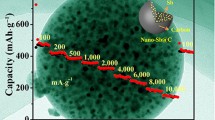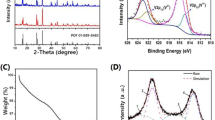Abstract
Sb-based compounds are regarded as promising anode materials for sodium ion batteries (SIBs). Here, uniform SbVO4 nanospheres with an average size of around 100 nm are prepared by a facile microwave hydrothermal treating the mixed solution of SbF3 and NaVO3 at 160 °C for 90 min. When evaluated as an anode material for SIBs, the SbVO4 electrode displays superior sodium storage properties with good cycling stability and high rate capability, delivering a high reversible capacity of 318 mAh/g after 50 cycles at 200 mA/g and even 210 mAh/g at high current densities of 2 A/g. This work opens the door for convenient synthesis of nanostructured SbVO4 as excellent anode materials for SIBs.






Similar content being viewed by others
References
Kim SW, Seo DH, Ma X, Ceder G, Kang K (2012) Electrode materials for rechargeable sodium-ion batteries: potential alternatives to current lithium-ion batteries. Adv Energy Mater 2(7):710–721
Yang Z, Zhang J, Kintner-Meyer MCW, Lu X, Choi D, Lemmon JP, Liu J (2011) Electrochemical energy storage for green grid. Chem Rev 111(5):3577–3613
Slater MD, Kim D, Lee E, Johnson CS (2013) Sodium-ion batteries. Adv Funct Mater 23(8):947–958
Wang H, Yang X, Wu Q, Zhang Q, Chen H, Jing H, Wang J, Mi S-B, Rogach AL, Niu C (2018) Encapsulating silica/antimony into porous electrospun carbon nanofibers with robust structure stability for high-efficiency lithium storage. ACS Nano 12(4):3406–3416
Lu JS, Maggay IVB, Liu WR (2018) CoV2O4: a novel anode material for lithium-ion batteries with excellent electrochemical performance. Chem Commun 54(25):3094–3097
Wang H, Huang H, Niu C, Rogach AL (2015) Ternary Sn–Ti–O based nanostructures as anodes for lithium ion batteries. Small 11(12):1364–1383
Cao D, Wang H, Li B, Li C, Xie S, Rogach AL, Niu C (2016) Hydrothermal synthesis of SnO2 embedded MoO3-x nanocomposites and their synergistic effects on lithium storage. Electrochim Acta 216:79–87
Doeff MM, Ma Y, Visco SJ, Dejonghe LC (1993) Electrochemical insertion of sodium into carbon. J Electrochem Soc 140(12):169–170
Yabuuchi N, Kubota K, Dahbi M, Komaba S (2014) Research development on sodium-ion batteries. Chem Rev 114(23):11636–11682
Chevrier VL, Ceder G (2011) Challenges for Na-ion negative electrodes. J Electrochem Soc 158(9):A1011–A1014
Tang K, Fu L, White RJ, Yu L, Titirici MM, Antonietti M, Maier J (2012) Hollow carbon nanospheres with superior rate capability for sodium-based batteries. Adv Energy Mater 2(7):873–877
Ponrouch A, Goñi AR, Palacín MR (2013) High capacity hard carbon anodes for sodium ion batteries in additive free electrolyte. Electrochem Commun 27(1):85–88
Zhu H, Jia Z, Chen Y, Weadock N, Wan J, Vaaland O, Han X, Li T, Hu L (2013) Tin anode for sodium-ion batteries using natural wood fiber as a mechanical buffer and electrolyte reservoir. Nano Lett 13(7):3093–3100
Hueso KB, Armand M, Rojo T (2013) High temperature sodium batteries: status, challenges and future trends. Energy Environ Sci 6(3):734–749
Su D, Wang C, Ahn HJ, Wang G (2013) Single crystalline Na0.7MnO2 nanoplates as cathode materials for sodium-ion batteries with enhanced performance. Chem Eur J 19(33):10884–10889
Wang J, Cao D, Yang G, Yang Y, Wang H (2017) Synthesis of NiS/carbon composites as anodes for high-performance sodium-ion batteries. J Solid State Electrochem 21(10):3047–3055
Yang X, Zhang J, Wang Z, Wang H, Zhi C, Yu DYW, Rogach AL (2018) Carbon-supported nickel selenide hollow nanowires as advanced anode materials for sodium-ion batteries. Small 14(7):1702669
Yang X, Wang H, Yu Denis YW, Rogach Andrey L (2018) Vacuum calcination induced conversion of selenium/carbon wires to tubes for high-performance sodium–selenium batteries. Adv Funct Mater 28(8):1706609
Bodenes L, Darwiche A, Monconduit L, Martinez H (2015) The solid electrolyte interphase a key parameter of the high performance of Sb in sodium-ion batteries: comparative X-ray photoelectron spectroscopy study of Sb/Na-ion and Sb/Li-ion batteries. J Power Sources 273:14–24
Li W, Wang K, Cheng S, Jiang K (2017) A two-dimensional hybrid of SbOx nanoplates encapsulated by carbon flakes as a high performance sodium storage anode. J Mater Chem A 5(3):1160–1167
Nam DH, Hong KS, Lim SJ, Kim MJ, Kwon HS (2015) High-performance Sb/Sb2O3 anode materials using a polypyrrole nanowire network for Na-ion batteries. Small 11(24):2885–2892
Liang L, Xu Y, Wang C, Wen L, Fang Y, Mi Y, Zhou M, Zhao H, Lei Y (2015) Large-scale highly ordered Sb nanorod arrays anode with high capacity and rate capability for sodium-ion batteries. Energy Environ Sci 8(10):2954–2962
Wang N, Bai Z, Qian Y, Yang J (2016) Double-walled Sb@TiO2−x nanotubes as a superior high-rate and ultralong-lifespan anode material for Na-ion and Li-ion batteries. Adv Mater 28(21):4126–4133
Hu MJ, Jiang YZ, Sun WP, Wang HT, Jin CH, Yan M (2014) Reversible conversion-alloying of Sb2O3 as a high-capacity, high-rate, and durable anode for sodium ion batteries. ACS Appl Mater Interfaces 6(21):19449–19455
Liu J, Yu LT, Wu C, Wen YR, Yin KB, Chiang FK, Hu RZ, Liu JW, Sun LT, Gu L, Maier J, Yu Y, Zhu M (2017) New nanoconfined galvanic replacement synthesis of hollow Sb@C yolk-shell spheres constituting a stable anode for high-rate Li/Na-ion batteries. Nano Lett 17(3):2034–2042
Wang H, Wang J, Cao D, Gu H, Li B, Lu X, Han X, Rogach AL, Niu C (2017) Honeycomb-like carbon nanoflakes as a host for SnO2 nanoparticles allowing enhanced lithium storage performance. J Mater Chem A 5(15):6817–6824
Wang J, Wang H, Li F, Xie S, Xu G, She Y, Leung MKH, Liu T (2019) Oxidizing solid Co into hollow Co3O4 within electrospun (carbon) nanofibers towards enhanced lithium storage performance. J Mater Chem A 7(7):3024–3030
Wang P, Xie S, She Y, Fan W, Leung MKH, Wang H (2019) Microwave-hydrothermal synthesis of hierarchical Sb2WO6 nanostructures as a new anode material for sodium storage. ChemistrySelect 4(3):1078–1083
Lu X, Wang Z, Liu K, Luo J, Wang P, Niu C, Wang H, Li W (2019) Hierarchical Sb2MoO6 microspheres for high-performance sodium-ion battery anode. Energy Storage Mater 17:101–110
Pan J, Zhang Y, Li L, Cheng Z, Li Y, Yang X, Yang J, Qian Y (2019) Polyanions enhance conversion reactions for lithium/sodium-ion batteries: the case of SbVO4 nanoparticles on reduced graphene oxide. Small Methods:1900231
Landa-Cánovas A, Nilsson J, Hansen S, Ståhl K, Andersson A (1995) On the nonstoichiometry in rutile-type ≈SbVO4. J Solid State Chem 116(2):369–377
Cavani F, Ligi S, Masetti S, Trifirò F (1998) SbVO4: the chemistry of preparation. In: Delmon B, Jacobs PA, Maggi R, Martens JA, Grange P, Poncelet G (eds) Studies in surface science and catalysis, Elsevier, p 377–384. Vol. 118
Lu X, Wang P, Liu K, Niu C, Wang H (2018) Encapsulating nanoparticulate Sb/MoOx into porous carbon nanofibers via electrospinning for efficient lithium storage. Chem Eng J 336:701–709
Lu X, Wang Z, Lu L, Yang G, Niu C, Wang H (2016) Synthesis of hierarchical Sb2MoO6 architectures and their electrochemical behaviors as anode materials for Li-ion batteries. Inorg Chem 55(14):7012–7019
Uchaker E, Zheng YZ, Li S, Candelaria SL, Hu S, Cao GZ (2014) Better than crystalline: amorphous vanadium oxide for sodium-ion batteries. J Mater Chem A 2(43):18208–18214
Liu S, Tong Z, Zhao J, Liu X, Wang J, Ma X, Chi C, Yang Y, Liu X, Li Y (2016) Rational selection of amorphous or crystalline V2O5 cathode for sodium-ion batteries. Phys Chem Chem Phys 18(36):25645–25654
Liu J, Xia H, Xue D, Lu L (2009) Double-shelled nanocapsules of V2O5-based composites as high-performance anode and cathode materials for Li ion batteries. J Am Chem Soc 131(34):12086–12087
Ramam K, Shaikh AM, Reddy BS, Viswamitra MA (1975) Crystal structure of ferroelectric sodium meta vanadate, NaVO3. Ferroelectrics 9(1):49–56
Xiong X, Wang G, Lin Y, Wang Y, Ou X, Zheng F, Yang C, Wang JH, Liu M (2016) Enhancing sodium ion battery performance by strongly binding nanostructured Sb2S3 on sulfur-doped graphene sheets. ACS Nano 10(12):10953–10959
Wu X, Yao S (2017) Flexible electrode materials based on WO3 nanotube bundles for high performance energy storage devices. Nano Energy 42:143–150
Funding
This work was financially supported by the Natural Science Basis Research Plan in Shaanxi Province (No. 2018JM5085), Tang Scholar Program from the Cyrus Tang Foundation, and the Natural Science Foundation for Youths of Hunan Provincial of China (No. 2019JJ50206).
Author information
Authors and Affiliations
Corresponding author
Ethics declarations
Conflict of interest
The authors declare that they have no conflict of interest.
Additional information
Publisher’s note
Springer Nature remains neutral with regard to jurisdictional claims in published maps and institutional affiliations.
Electronic supplementary material
ESM 1
(DOC 206 kb)
Rights and permissions
About this article
Cite this article
Yang, H., Wang, P., Zhang, J. et al. Microwave hydrothermal synthesis of SbVO4 nanospheres as anode materials for sodium ion batteries. Ionics 26, 1267–1273 (2020). https://doi.org/10.1007/s11581-019-03308-7
Received:
Revised:
Accepted:
Published:
Issue Date:
DOI: https://doi.org/10.1007/s11581-019-03308-7




